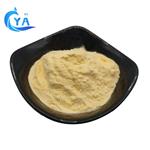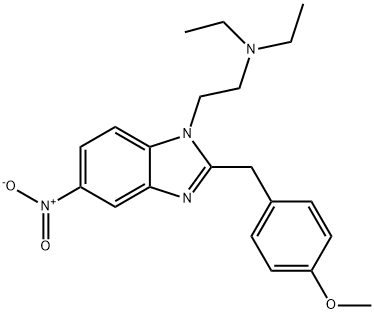Metonitazene: A Potent Novel Opioid with Toxicological and Metabolic Insights
Metonitazene is classified as a novel opioid but is dissimilar from fentanyl and U-series analogues. Novel opioids have been reported to cause psychoactive effects similar to heroin, fentanyl, and other opioids. Novel opioids have also caused adverse events, including deaths, as described in the literature. Structurally similar compounds to metonitazene include etonitazene, isotonitazene, and clonitazene. These synthetic opioids were first synthesized and reported in the literature in the 1950s.1 Data suggests that this group of analogues have potency similar to or greater than fentanyl.2 Etonitazene is reported to be the most potent followed by isotonitazene and metonitazene. Isotonitazene was previously confirmed by NPS Discovery in November 2019, followed by proliferation in the United States initiating from the midwestern region3,4 Tentative identification of metonitazene was previously reported in March 2019 out of Canada (Alberta) from testing of drug paraphernalia also containing isotonitazene. Metonitazene is considered a new psychoactive substance (NPS) and emerging potent synthetic opioid, causing increased public health concern beginning in 2020. Metonitazene joins a growing list of new synthetic opioids (NSOs) contributing to deaths among people who use drugs in the United States and other parts of the world.

Metonitazene-Forensic toxicology assessment of a potent new synthetic opioid
While it has become apparent that opioids present ongoing threats to health and wellness, early identification of NPS and addition to forensic and clinical laboratory testing scopes are essential to understanding the extent of appearance and proliferation, contribution to adverse effects and deaths, and impacts of intervention in reducing associated harms. Innovative laboratory efforts to remain abreast of changing drug landscapes have become a vital aspect to tackling and properly diagnosing these various issues. In January 2021, immediately after an observed increase in metonitazene-related adverse events, our laboratory issued a public health alert to diverse stakeholders (including public health and safety agencies, poison centers, medical toxicologists, emergency room physicians, regulators, and law enforcement agencies) to raise awareness that this NSO was causing intoxications and deaths. At that time, metonitazene was linked to eight deaths centered around the Midwestern United States. Since, additional cases positive for it were identified and forwarded to the CFSRE for additional testing. Herein, we report data from comprehensive toxicological assessment of metonitazene in postmortem cases, including quantitative confirmations, assessment of poly-drug use, metabolite profiling, and detailed case histories and autopsy findings.[1]
Metonitazene is the latest potent NSO to emerge in the United States and Europe with regularity. Little information about this drug was known prior to its emergence on the recreational drug market, and no peer-reviewed publications existed regarding its involvement in toxicology cases. In late 2020, our laboratory began detecting metonitazene in biological samples collected as part of forensic investigations. Metonitazene underwent N-dealkylation and O-dealkylation, similar to the metabolism of many NPS. N-Desethyl metonitazene was produced via N-deethylation and observed to be a prominent metabolite in urine and vitreous samples. N-Desethyl metabolites of “nitazene” (2-benzylbenzimidazole) analogues are shown to retain activity and, in some cases (e.g., isotonitazene), are more potent in vitro than the parent drug. Further testing was conducted to assess its concentrations, co-occurrence with other drugs, toxicity, and metabolism. Metonitazene was listed as a cause of death in three cases (manner of death: accident), demonstrating the potential lethal effects of this new opioid and its use resulting in death. As with all emerging NPS, laboratories should consider these results in the context of including new drugs in testing panels, and toxicologists should consider these results (and others) when interpreting casework involving metonitazene and its closely related analogues.
Human metabolism of metonitazene
In the early 2010s, the USA was struck by the “opioid crisis”, as illicit fentanyl and new synthetic opioids (NSOs) flooded the illegal drug market. Benzimidazole opioids are µ-opioid receptor (MOR) agonists with antinociceptive properties. Although the potency of some of these compounds is similar to that of morphine, the pharmacological activity of several analogues, such as etonitazene, isotonitazene, metonitazene, and etonitazepyne, is similar or even much higher compared to that of the medically used, highly potent opioid fentanyl. Metabolite detection is critical to document drug consumption in clinical and forensic settings, and phase I metabolites of isotonitazene and metonitazene have been identified in authentic cases of consumption. To continue these efforts to describe the metabolism of emerging opioids, the aim of the present study was to investigate the human metabolism of isotonitazene and metonitazene in human hepatocyte incubations as well as in positive samples from postmortem cases to confirm the previously published data, include phase II metabolites, and verify suitability of the in vitro model for predicting the metabolism of benzimidazole opioids in humans. This model was then applied to etodesnitazene and metodesnitazene to identify suitable metabolite biomarkers of consumption.[2]
In urine, O-dealkyl and N-deethyl-O-dealkyl metabolites and glucuronides were predominant. Isotonitazene and metonitazene O-dealkyl metabolites were the same molecules and are also likely produced through the metabolization of structural analogues such as etonitazene, protonitazene, or butonitazene, whose only difference from isotonitazene and metonitazene is the composition of the alkoxy side chain. Similarly, etodesnitazene and metodesnitazene O-dealkyl metabolites were also the same molecules and might be produced through isotodesnitazene or protodesnitazene metabolization. In blood, the N-deethyl metabolite was preponderant for metonitazene and etodesnitazene, and O-deethyl-etodesnitazene and N,O-dideethyl-etodesnitazene were also major in the etodesnitazene-positive sample. As for O-dealkyl metabolites, N-deethyl metabolites also might not be specific. The present study explored the human metabolism of four nitazene analogues, isotonitazene, metonitazene, etodesnitazene, and metodesnitazene. The identification of these synthetic opioids’ metabolites is especially important considering that several metabolites proved to be highly potent MOR agonists in vitro. Specific metabolite biomarkers were found to help analytical toxicologists’ documentation of clinical and forensic opioid intoxication cases and enable further pharmacokinetic studies.
References
[1]Krotulski, Alex J et al. “Metonitazene in the United States-Forensic toxicology assessment of a potent new synthetic opioid using liquid chromatography mass spectrometry.” Drug testing and analysis vol. 13,10 (2021): 1697-1711. doi:10.1002/dta.3115
[2]Taoussi O, Berardinelli D, Zaami S, Tavoletta F, Basile G, Kronstrand R, Auw?rter V, Busardò FP, Carlier J. Human metabolism of four synthetic benzimidazole opioids: isotonitazene, metonitazene, etodesnitazene, and metodesnitazene. Arch Toxicol. 2024 Jul;98(7):2101-2116. doi: 10.1007/s00204-024-03735-0. Epub 2024 Apr 6. PMID: 38582802; PMCID: PMC11169013.
You may like
See also
Lastest Price from Metonitazene manufacturers

US $0.00/kg2025-03-18
- CAS:
- 14680-51-4
- Min. Order:
- 1kg
- Purity:
- 0.99
- Supply Ability:
- 10T

US $0.00/kg2024-06-11
- CAS:
- 14680-51-4
- Min. Order:
- 1kg
- Purity:
- 99%
- Supply Ability:
- 100 tons


